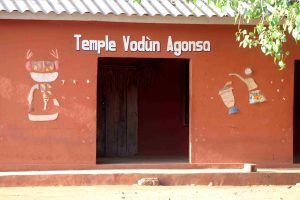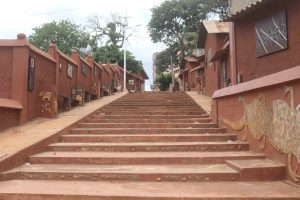We’ve got a problem. We have no money. Well, we have plenty of US$ and Euros, but we haven’t got West African Francs anymore. And in Porto Novo, the capital of Benin, for crying out loud, it turns out not to be that easy to change. The concept of going into a bank, offering foreign currency and receiving local money in return is alien, it seems; the first two banks we enter don’t do this kind of strange transactions. The ATMs also routinely refuse my bankcard, and at a Western Union office that claims to exchange foreign currency, they take 40 minutes to come up which such an unfavourable exchange rate, that we walk out in disgust.
And then, pretty far out of the centre, we do find a bank that wants to change our money. It takes a while – I estimate that about two/thirds of the approximately 15 employees of the bank have, at one stage, had a role to play in the approval and pay out process – but after another 40 minutes we walk out with local currency. By now, the morning has gone.
The Voodoo quartier
With the now familiar, but still no less scary moto taxi we get back to the centre of town. We want to find the Zangbeto Zohomy, a Voodoo temple – I think – in the Adjinan neighbourhood. I still don’t know whether we ever found it, but we do encounter lots of completely unexpected things. Firstly, we come upon a Royal Palace, at least that is what it said on the outside, which is housing a local open air art exhibition. There is nobody, but the door is open, so we look around, and admire the variety of art works – paintings, masks, mixed media, metal sculptures. All of it quite different from what we are used to in a western context, which makes it so interesting. And many of the works seem to have a distinct Voodoo theme.
The palace walls are red-brown mud, quite like a lot of the other buildings in the neighbourhood. Many of the walls support symbols, of people, of utensils, and of things unrecognisable so far. And then it dawns on us: this is just one big Voodoo neighbourhood, with sacred trees, offerings, and indeed, a little further, another temple. Everything here just oozes Voodoo, but not like something secret, hidden, like in Haiti. It is more like what we saw yesterday, except that that was a single temple, here every compound seems to be part of the religion.

and the wall decoration next to the temple, the black-and-white images perhaps referring to individual spirits
We meet up with Profet – really -, who wants to be our guide. And indeed, he stops at every little cove, every building, every tree, to explain its role in Voodoo. On the walls of the Djissoo-Gbogan temple are two symbols of Tchinan, a spirit who is either carried on the head or on the shoulders. The Ahos (?) is a kind of xylophone, a rarely played instrument. More common are the metal horn and the pot, which is also played as an instrument, to announce the passing away of a king. Lots of altar-type coves show signs of active offerings, not in the least the ones to Legba, an important spirit we remember from Haiti. The python temple, dedicated to Dans, the spirit who stands for intelligence, skilfulness and beauty, is recognised by a white flag – well, and the python symbol, of course, on the outside. Dans is the only spirit that does not accept blood as an offering, which works out fine, because he is also very popular with parents who fear that their children are perhaps not so smart, or not so pretty, and ask Dans to interfere.
In several places we encounter Zangbeto covers, the Zangbetos being the night guards who move around in a raffia suit. They are well organised, and act, or acted, as a kind of police. The square in front of the Agonso temple, in the heart of Adjinan neighbourhood, has one of the few non-sacred trees, the Gunu tree, also called beard tree, which provides a certain freshness. But on the side is the Iroko tree, the most sacred one of all the trees, and that is obvious from the many small baskets left there, all used for an offer or a sacrifice. A stick with snails, leaning against the Iroko, is to protect the house, the idea being that a thief at once moves so slowly, that he cannot escape anymore. But perhaps the most poignant symbol is the collection of cloth, next to the tree. These are the shirts, the trousers of people who have died in an accident, or a fire; by pinning it here the community is asking the spirits not to let this happen again.
Voodoo is probably one of the oldest religions in the world, and it is incredibly complex. Profet is at pains to stress that the myths of Westerners, about black magic, is not what Voodoo is about, instead it is a religion promoting peace and harmony – true, that is what every religion claims, of course. Where we in the west pray to God, the people of Voodoo communities approach the king if they have identified a problem – children dying too young, harvest failed, you name it. The king then asks the Bokono, the chief priest, to consult the oracle, a process that involves cowrie shells and cola nuts. Depending how the cola nuts fall, the priest interprets what to do next. Obviously, the priest never lies, if he would do so, he dies. I am sure Profet has told me much more, it is simply too much to remember all – and no doubt too much to share here, I am sure you have had quite enough now.
.
Except that on our way down we pass the Rue des Artistes, Voodoo artists who have contributed to beautifying the stairs that lead to the main road below. Here again, every symbol attracts a comment, an explanation from Profet. I decide to focus on the aesthetic beauty of the art works, noting that many are made by the same artists that we found at the beginning of our walk here, in the palace gallery. Fascinating, all of it.
Next: there is even more in Porto Novo












































Hallo Sofia en Bruno, jullie waren een hele tijd van mijn radar verdwenen totdat ik ontdekte dat jullie in mijn spam box zaten😁. Zo fascinerend om jullie reisverhalen te lezen en zo kennis te maken met andere culturen! Hartelijke groet, Dorry